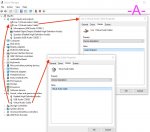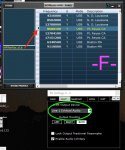Hi, I'm completely new to SDR and decoding but I hope someone suggest something I haven't tried yet to fix this problem. I posted this on the Nbems forum but have received no replies so far. Meanwhile I thought I'd ask if anyone here can assist.
(I'm expecting some antenna components to arrive and while waiting, I've been surfing around on the AirSpy server Network. There are so many signals and modes available that I wonder if I really need to bother with an SDR device at all. However, that's another story).
My problem
I'm trying to get SDR Sharp to "talk" to Fldigi (or Fldigi to "listen" to SDR Sharp) via the free VB audio cable driver when trying to decode for example, a simple RTTY 45/170 signal (the only mode I've so far learned to identify from the sound). There's no waterfall on Fldigi and only gibberish on the output screen. At this point, I don't know if it's SDR Sharp or Fldigi that's the problem or something with the way I have my PC setup or a combination of all three. I couldn't see anything in the Fldigi manual that covers using the app with an SDR.
I've been at this for several days now and reading stuff on various forums from others who seem to have similar problems but I haven't found a solution yet. A clean re-install of SDR# and the VB driver as well as Fldigi didn't improve things. I also tried the alternative VAC_Lite audio cable because someone posted that this had fixed the same problem but it made no difference. Obviously, I'm missing something and knowing me, it'll probably turn out to be something completely stupid that I forgot to do. I just haven't found out what yet. Any advice about this would be appreciated.
Generic RTL-SDR dongle
OS Windows Pro x64 (19042.844)
SDR# v1.0.0.1810
VB Cable Pack43, VACLite465
Fldigi v4.1.18
Thanks for reading.
(I'm expecting some antenna components to arrive and while waiting, I've been surfing around on the AirSpy server Network. There are so many signals and modes available that I wonder if I really need to bother with an SDR device at all. However, that's another story).
My problem
I'm trying to get SDR Sharp to "talk" to Fldigi (or Fldigi to "listen" to SDR Sharp) via the free VB audio cable driver when trying to decode for example, a simple RTTY 45/170 signal (the only mode I've so far learned to identify from the sound). There's no waterfall on Fldigi and only gibberish on the output screen. At this point, I don't know if it's SDR Sharp or Fldigi that's the problem or something with the way I have my PC setup or a combination of all three. I couldn't see anything in the Fldigi manual that covers using the app with an SDR.
I've been at this for several days now and reading stuff on various forums from others who seem to have similar problems but I haven't found a solution yet. A clean re-install of SDR# and the VB driver as well as Fldigi didn't improve things. I also tried the alternative VAC_Lite audio cable because someone posted that this had fixed the same problem but it made no difference. Obviously, I'm missing something and knowing me, it'll probably turn out to be something completely stupid that I forgot to do. I just haven't found out what yet. Any advice about this would be appreciated.
Generic RTL-SDR dongle
OS Windows Pro x64 (19042.844)
SDR# v1.0.0.1810
VB Cable Pack43, VACLite465
Fldigi v4.1.18
Thanks for reading.








